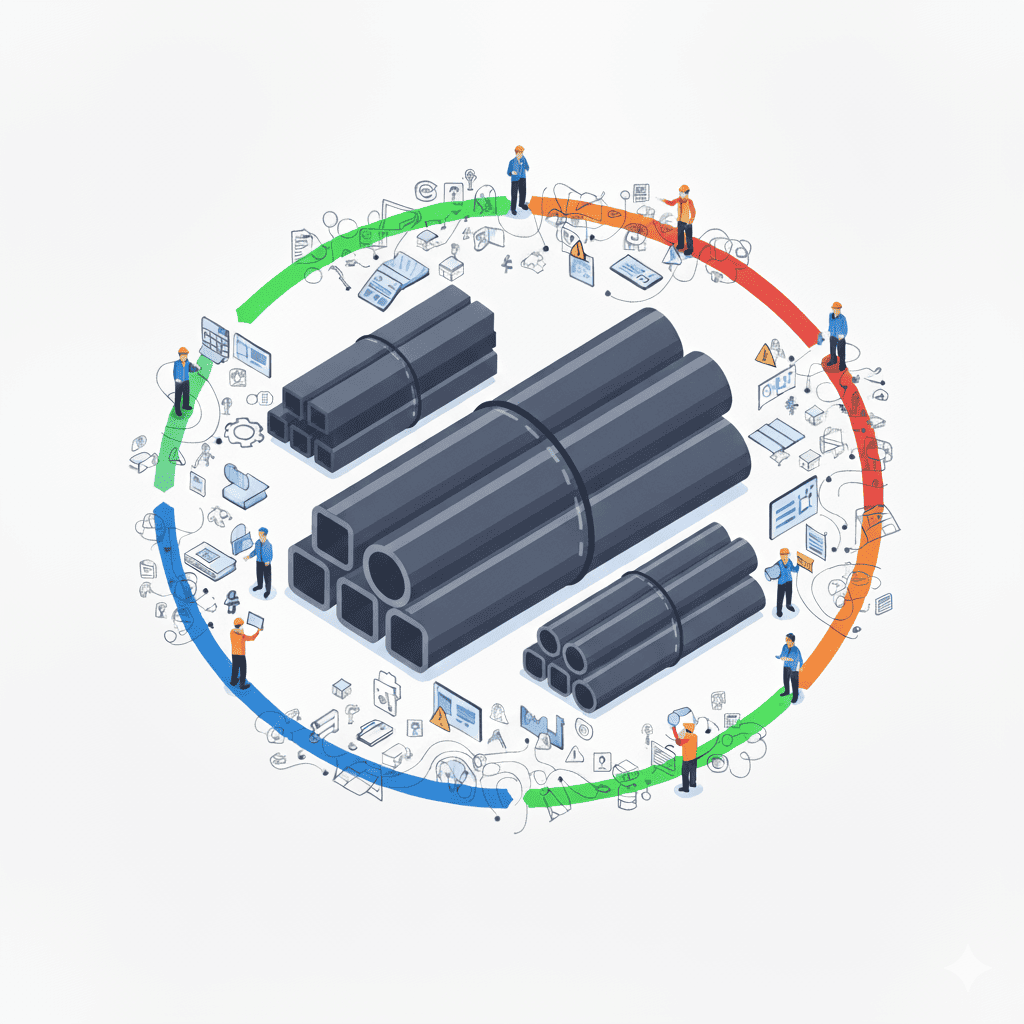ERW Pipe and Tube Standards: Technical Reference and Compliance Guide

Introduction
At SPAR Steel Industries, we understand the complexities engineers, contractors, and procurement teams face when specifying Electric Resistance Welded (ERW) pipe and tube standards and schedule (SCH) classifications, especially with multiple systems—BS, EN, ASTM, and IS—where technical clarity and compliance can easily get lost in translation.
This article, “ERW Pipe and Tube Standards: Technical Reference and Compliance Guide,” is designed to simplify your process. It compiles essential technical references and provides real-world context drawn from our extensive manufacturing and QA/QC experience. We’ve laid out clear tables, terminology, and comparisons to help you make informed, confident choices in your day-to-day work.
- Understand how SCH numbers (5–160) affect wall thickness, pressure handling, and flow capacity.
- Select the right material grades across ASTM A53/A500, EN 10219/10210, BS 1139/1387, and IS 1239/3589 standards.
- Use a compliance matrix to align project requirements from ADNOC, Aramco, and other EPC clients with SPAR’s product range.
- Implement better QA/QC, embossing, and documentation practices to speed up inspections and approvals.
ERW Pipe and Tube Schedule Fundamentals
“Schedule” (SCH) denotes a standardized wall thickness series defined by ASME B36.10/B36.19. For a given Nominal Pipe Size (NPS), the outside diameter remains constant; as the schedule increases (e.g., SCH 40 → SCH 80 → SCH 160), the wall thickens, the internal diameter reduces, and the pipe’s pressure rating rises. In practice, engineers choose the lightest schedule that safely meets pressure, temperature, and structural constraints, factoring in corrosion allowances, fabrication, and lifecycle cost.
Typical usage bands: SCH 20/30/40 (standard-weight) for general utilities; SCH 80 (extra-strong) where pressure and mechanical loads are higher; SCH 120/160/XXS applied selectively in critical, high-pressure services. For structural and scaffolding, SCH is less common than standards such as EN 10219 or BS 1139, yet the concept remains useful to understand wall-thickness implications.
ERW Pipe and Tube Wall Thickness Reference (NPS ½″–12″, Selected Schedules)
The table below presents widely used schedule thicknesses for reference in pre-bid and quick-check scenarios. Values are representative; always confirm the final sizes against the governing code edition, client spec, and approved mill test certificates (MTC 3.1).
| NPS (in.) | OD (mm) | SCH 40 (mm) | SCH 80 (mm) | SCH 160 (mm) |
| 1/2 | 21.3 | 2.77 | 3.73 | 4.78 |
| 3/4 | 26.7 | 2.87 | 3.91 | 5.56 |
| 1 | 33.4 | 3.38 | 4.55 | 6.35 |
| 1-1/4 | 42.2 | 3.56 | 4.85 | 6.35 |
| 1-1/2 | 48.3 | 3.68 | 5.08 | 7.14 |
| 2 | 60.3 | 3.91 | 5.54 | 7.01 |
| 2-1/2 | 73.0 | 5.16 | 7.01 | 9.53 |
| 3 | 88.9 | 5.49 | 7.62 | 11.13 |
| 3-1/2 | 101.6 | 5.74 | 8.08 | 12.70 |
| 4 | 114.3 | 6.02 | 8.56 | 13.49 |
| 5 | 141.3 | 6.55 | 9.53 | 15.88 |
| 6 | 168.3 | 7.11 | 10.97 | 17.48 |
| 8 | 219.1 | 8.18 | 12.70 | 23.01 |
| 10 | 273.1 | 9.27 | 15.09 | 28.58 |
| 12 | 323.9 | 9.53 | 17.48 | 33.32 |
Note: OD is per ASME B36 series.
For sizes beyond 12″ (e.g., 14″–24″) and for additional schedules (5/10/20/30/XS/XXS), contact SPAR or refer to the live datasheet to ensure the latest code edition and client-specific allowances are applied.
International Standards and Grades (BS, EN, ASTM, IS)
Different industries and regions prefer different codes. For structural tubes and scaffolding in EMEA, EN and BS dominate; for piping in the Americas and many global EPCs, ASTM/ASME is prevalent; while Indian Standards are common across the Subcontinent and in certain GCC procurement drives.
• ASTM A53 (ERW/Seamless): Black and hot-dip galvanized pipe for mechanical/pressure uses.
• ASTM A500 (ERW): Cold-formed welded/seamless structural tubing in round/SHS/RHS; common grades A/B/C.
• EN 10219 (ERW): Cold-formed structural hollow sections (e.g., S355J2H) widely adopted for scaffolding/structures.
• EN 10210 (Hot finished): Higher toughness/ductility for demanding structural applications.
• BS 1139 (Scaffolding): Steel tubes and couplers; frequently invoked by Aramco/ADNOC heritage specs.
• BS 1387 (Welded tubes for gas/water): Precursor widely referenced for general-purpose welded pipes.
• IS 1239 / IS 3589 (ERW pipe and tube Standards): Medium/heavy classes for water, steam, and structural; IS 4923 for hollow sections.
SPAR Compliance Matrix (Condensed)
Alignment between SPAR products and commonly requested standards for GCC oil & gas and infrastructure projects:
| SPAR Product | BS | EN | ASTM | IS | SPAR Conformance (Examples) |
| ERW Scaffolding Tubes (48.3 × 3.2 mm) | BS 1139 | EN 10219 | A500 (Gr. B/C) | IS 1239 | Embossed traceability; tolerances per EN 10219 |
| Structural Hollow Sections (RHS/SHS/CHS) | BS 4360 (legacy) | EN 10210/10219 | A500 | IS 4923 | Grades up to S355J2H; CVN options |
| Black/Galv. Process Pipes | BS 1387 | EN 10255 | A53 Gr. A/B | IS 3589 | Hot-dip galvanizing to ISO 1461 |
| Cuplock System Tubes/Brackets | BS 1139-2 | EN 12811/EN 74 | A500 | – | SP-LOK tested; EN 74-B couplers |
| LVL & Steel Boards (SPARDECK) | BS 2482 | EN 12811 | – | IS 1079 | Anti-slip options; fire-retardant variants |
Documentation: MTC 3.1, heat number mapping, and embossing (“SPAR UAE EN 10219 / BS 1139”) ensure inspection traceability. Where owner specs demand higher notch toughness or specific chemistry, SPAR aligns heat treatment and test sampling accordingly.
QA/QC, Testing, Embossing, and Safety Integration
Our quality process spans several critical stages:
- Incoming Material Checks: Verification of raw coil (chemistry, mechanicals).
- Manufacturing Control: Monitoring of ERW welding parameters (HF weld monitoring) and NDT (where specified).
- Dimensional Integrity: Dimensional checks performed according to the specified code.
- Coating Verification: Galvanizing mass verification for coated products.
- Final Assessment: Comprehensive final visual inspection.
Traceability is ensured through detailed Embossing, which includes the manufacturer ID, size, wall thickness, heat number, and relevant code, enabling true cradle-to-grave tracking.
Scaffolding Standards Compliance
For our scaffolding supply, compliance is managed by referencing key safety and owner-specific standards:
- General Safety: We reference OSHA 1926 Subpart L for safe use guidelines.
- Owner Standards: Specific requirements from major clients, such as Aramco GI 8.001 and ADNOC Codes of Practice, are strictly addressed in our project-specific method statements and submittals.
Application Guidance (Selection, Design, and Procurement)
- Selection: Start with process/structural load cases, temperature, corrosion allowance, and erection method. Align target code (ASTM/EN/BS/IS) early.
- Design: Coordinate OD/WT with fittings, supports, and scaffolding ledger-transom grids. For scaffold platforms, confirm duty class and plank choice.
- Procurement: Specify code edition, grade, NPS/OD, schedule/WT, end finish, galvanizing standard, and documentation set (MTC 3.1, inspection certificates).
ERW Pipe & Tube Manufacturers Reference List.
The following manufacturers are frequently referenced in global ERW/welded tubular sourcing:
- Tenaris — https://www.tenaris.com/
- EEW Group — https://eew-group.com/
- TMK Group — https://www.tmk-group.com/
- ArcelorMittal Tubular Products — https://projects.arcelormittal.com/energy/products-services/pipes-tubulars/
- Welspun Corp — https://www.welspuncorp.com/
- United Steel Industry Co., Ltd. — https://www.united-steel.com/
- Baolai Steel Pipes — https://baolaipipes.com/
- Maharashtra Seamless Ltd (Jindal Group) — https://www.jindal.com/msl/erw-pipes.html
- APL Apollo Tubes Ltd. — https://www.aplapollo.com/
- SPAR Steel Industries (UAE) — https://www.sparsteel.com/
In project submittals, SPAR can cross-qualify to specific client lists and provide equivalence notes where third-party approvals are required.
Logistics, Packaging, and Documentation for Approvals

At SPAR Steel, we also place strong emphasis on packaging and documentation to ensure smooth delivery and faster inspections following ERW Pipe and Tube Standards.To begin with, our packaging process maintains consistency in bundle weights, strap spacing, end protection, and color coding for quick identification at site. In addition, our shipping documentation is prepared in detail and includes packing lists by heat and size, tally sheets, mill test certificates (MTCs), galvanizing certificates, and compliance statements that align with each project’s specifications.
Sustainability and Lifecycle Considerations
ERW pipes and galvanized scaffolding can be reused over multiple cycles, reducing embedded carbon per use. SPAR prioritizes coil sourcing from reputable mills, efficient galvanizing practices, and material recovery at end-of-life. Where requested, Environmental Product Declarations (EPDs) can be supported.
Conclusion
The world of ERW pipe, tube, and scaffolding is governed by a patchwork of global standards—BS, EN, ASTM, and IS—which therefore demand precision and constant cross-referencing. As a result, navigating the specifications for SCH classifications, material grades, and quality assurance requires a technical and practical compliance mindset. To address this need, we have compiled these essential references and contextualized them with our manufacturing expertise at SPAR Steel Industries, making this guide a valuable resource. Ultimately, this resource helps engineers, contractors, and procurement teams reduce complexity and ensure confident, compliant product selection for their critical projects.
For more info: www.sparsteel.com



